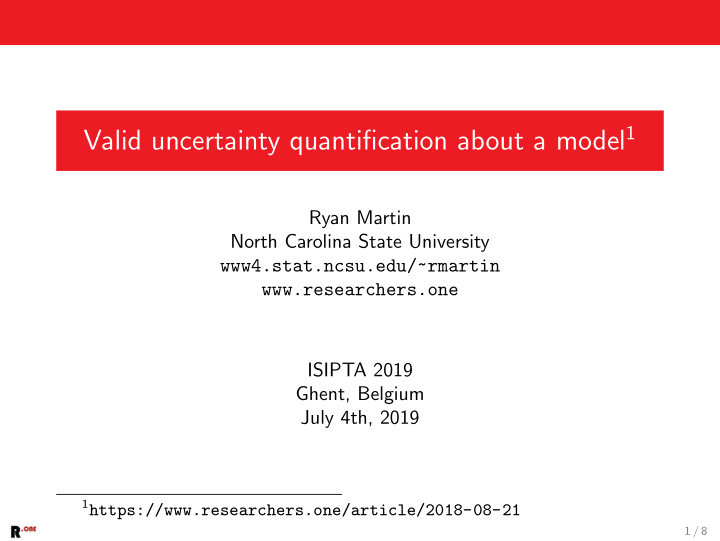



Valid uncertainty quantification about a model 1 Ryan Martin North Carolina State University www4.stat.ncsu.edu/~rmartin www.researchers.one ISIPTA 2019 Ghent, Belgium July 4th, 2019 1 https://www.researchers.one/article/2018-08-21 1 / 8
Setup Consider a classical statistical inference problem: observable data Y ; statistical model Y ∼ P Y | θ depending on θ ∈ Θ; goal is to quantify uncertainty about θ based on Y = y . For statistical inference to be valid (in a sense), uncertainty must be quantified as a non-additive belief. 2 But non-additivity alone isn’t enough, some care is needed in the construction. How to construct an inferential model that’s valid? 2 M. (2019) “False confidence, non-additive beliefs, and valid statistical inference,” based on my BELIEF 2018 lecture; on Researchers.One and IJAR . 2 / 8
Valid inferential models Express statistical model via an “association” Y = a ( θ, U ) , U ∼ P U . We don’t observe U , but can use a suitable random set , S ∼ P S , to predict/guess its value. Push the random set through ( y , assoc) to Θ, � Θ y ( S ) = { ϑ : y = a ( ϑ, u ) } . u ∈S Distribution of S induces y -dependent non-additive beliefs: bel y ( A ) = P S { Θ y ( S ) ⊆ A } pl y ( A ) = 1 − bel y ( A c ) , A ⊆ Θ . 3 / 8
Commercial Still looking for the perfect summer-time read...? 4 / 8
This paper Stuff described above takes the statistical model as given. What if the statistical model itself is also uncertain? Express the “parameter” as θ = ( M , θ M ), where M is a model index θ M is a model-specific parameter Then θ M is a nuisance parameter. Dealing with model uncertainty is like marginal inference... 5 / 8
This paper, cont. My approach handles marginal inference by manipulating the association, to isolate the interest parameter. General details in paper and poster. Here I’ll just make an analogy to linear regression: re-express data as (suff stat , residuals) if model is given, ignore the residuals if model is uncertain, use the residuals After marginalization is complete, proceed with the same random set business to get a valid inferential model for M . 6 / 8
One more commercial Existing peer review system is detrimental in various ways. More on this later... Successful reform requires new ideas, and action. H. Crane and I developed a new open-access publication platform, featuring an author-driven peer review process. For details, check us out at www.researchers.one www.twitter.com/@ResearchersOne 7 / 8
The end Thanks! rgmarti3@ncsu.edu www4.stat.ncsu.edu/~rmartin 8 / 8
Recommend
More recommend